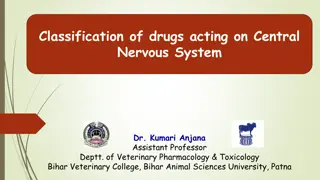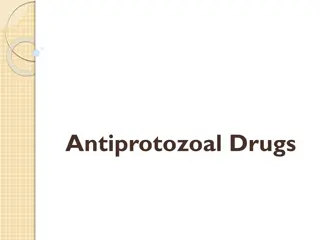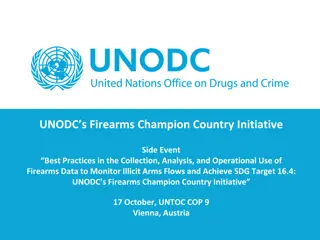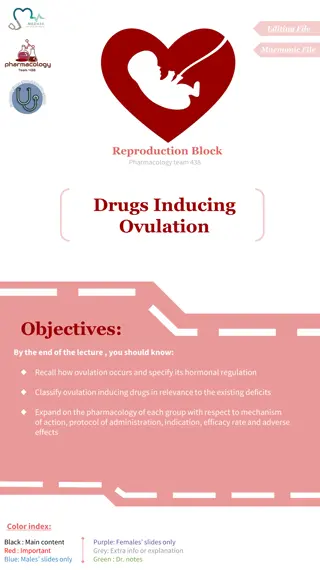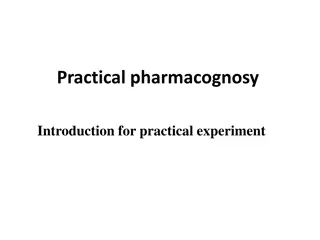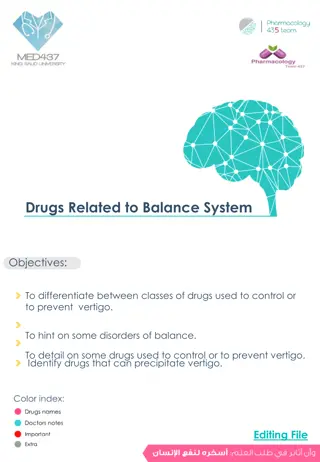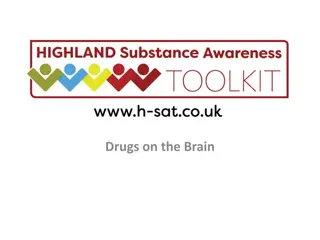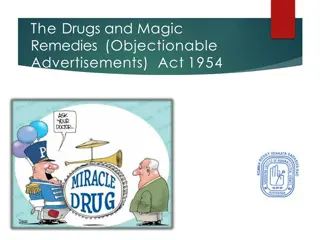Understanding Illicit Drugs: Risks and Realities
Explore the world of illicit drugs from a research-based perspective. Uncover the dangers and consequences of drug use, learn about the signs of drug use, understand where drugs come from, and discover the effects of various types of illicit substances. Delve into the intersection of drug use with diving activities and gain insights into why avoiding drug use is essential for personal well-being.
Download Presentation

Please find below an Image/Link to download the presentation.
The content on the website is provided AS IS for your information and personal use only. It may not be sold, licensed, or shared on other websites without obtaining consent from the author. Download presentation by click this link. If you encounter any issues during the download, it is possible that the publisher has removed the file from their server.
E N D
Presentation Transcript
DDRC Healthcare Looking at Illicit Drugs Compiled by the DDRC Healthcare research team www.ddrc.org info@ddrc.org facebook and twitter - @DDRCPlymouth
Illicit drugs Why do we need to attend this presentation, and what will we learn? Learn about illicit (recreational) drugs and understand why it may not be a good idea to do drugs and dive Results of real research from DDRC concerning the use of illicit drugs by divers
Illicit drugs Anecdotally some divers are combining illicit drug use with diving activities Little or no understanding within diving community Residual/detection times Interaction of drugs with diving environments Physical and psychological effects
Illicit drugs FAQs about illicit drugs How pure are street drugs? What are the signs of drug use? What are the dangers from using drugs? Where do drugs come from? What do drugs look like?
Illicit drugs How pure are street drugs? You have no way of knowing because there is no quality control What are the signs of drug use? These might be changes mood swings, changes in appearance, excessive tiredness, lack of appetite But be careful, any of these signs may be due to other non-drug related issues in a person s life
Illicit drugs Where do drugs come from? Grown in the UK, made in domestic labs, stolen or sold on from chemists or hospital pharmacies, imported from overseas, or bought online The Netherlands, Belgium, eastern Europe, China and the Far East
Illicit drugs What are the dangers from using drugs Heroin and tranquillisers have a sedative effect slowing down the way the body and brain function Amphetamines, cocaine, crack and ecstasy have a stimulant effect giving a rush of energy and making people more alert LSD, magic mushrooms, and also cannabis and ecstasy have a hallucinogenic effect, altering the way the user feels, sees, hears, tastes or smells
Illicit drugs National UK Data The British Crime Survey (BCS) is the most reliable source of illicit drug data in the UK In the 2018 survey 18,053 hospital admissions for poisoning by drug misuse 34.2% had taken an illicit drug in their lifetime 9.4% in the previous 12 months (adults aged 16-59) 3.7% in the last 12 months used a Class A drug Cannabis/marijuana the most used drug
Illicit drugs Research What DDRC researchers wanted to know .. Investigate illicit drug use in UK sport divers Type, class, and use of drug closest to time of diving
Illicit drugs Research results DDRC collected data from 531 divers 68% males, 32% females Age ranged 13-70 years (median 43) 45% of divers had more than 10yrs diving experience 388,209 dives (322,773 male, 65,436 female) since learning to dive
Illicit drugs Research results Figure 1. Receational Drug use BCS vs Divers BCS Divers 40% 35% 30% 25% 20% 15% 10% 5% 0% BCS life time vs divers in last 12 months in the last month since learning to dive 22% had used one or more illicit/recreational drugs since learning to dive (62% males, 38% females) 3.5% used one or more drugs in the last 12 months 3% in the last month
Illicit drugs Research results Figure 2. Type of Drug Use in the Last 12 Months: BCS vs Divers Figure 1. Receational Drug use BCS vs Divers BCS Divers 40% BCS Divers 35% 8% 7% 30% 6% 25% 5% 20% 4% 15% 3% 10% 2% 5% 1% 0% 0% Cannabis Cocaine Ecstasy Amphetamines LSD & Magic BCS life time vs divers in last 12 months in the last month Mushrooms since learning to dive 22% had used one or more illicit/recreational drugs since learning to dive (62% males, 38% females) 3.5% used one or more drugs in the last 12 months 3% in the last month Cannabis was the most used drug
Illicit drugs Research results Figure 2. Type of Drug Use in the Last 12 Months: BCS vs Divers Figure 1. Receational Drug use BCS vs Divers BCS Divers 40% BCS Divers 35% 8% 7% 30% 6% 25% 5% 20% 4% 15% 3% 10% 2% 5% 1% 0% 0% Cannabis Cocaine Ecstasy Amphetamines LSD & Magic BCS life time vs divers in last 12 months in the last month Mushrooms since learning to dive 22% had used one or more illicit/recreational drugs since learning to dive (62% males, 38% females) Figure 3. Class A Drug use: BCS vs Divers BCS Divers 16% 3.5% used one or more drugs in the last 12 months 14% 12% 10% 3% in the last month 8% 6% Cannabis was the most used drug 4% 2% 9% used a class A drug since learning to dive 0% BCS life time vs divers class A in last 12 months class A in last month since learning to dive
Illicit drugs Research results Type of illicit drugs used Some divers reported using more than one drug type Cannabis Cocaine Ecstasy Magic mushrooms Amphetamines LSD Tranquillisers Barbiturates Heroin Some divers reported using more than one type of drug
Illicit drugs Research results Type of illicit drugs used Some divers reported using more than one drug type Hallucinogen and Stimulant Use Within the Drug Group Cannabis Cocaine Ecstasy Magic mushrooms Amphetamines LSD Tranquillisers Barbiturates Heroin Hallucinogens Stimulants Stimulants and hallucinogens Stimulants, hallucinogens, tranquillisers Some divers reported using more than one type of drug
Illicit drugs Research results Type of illicit drugs used Some divers reported using more than one drug type Hallucinogen and Stimulant Use Within the Drug Group Cannabis Cocaine Ecstasy Magic mushrooms Amphetamines LSD Tranquillisers Barbiturates Heroin Hallucinogens Stimulants Stimulants and hallucinogens Stimulants, hallucinogens, tranquillisers 21% of the illicit drug group had used a class A or B drug between 5 minutes to 24 hours before diving Class of Drug Use Class A Class A/B Class B Cannabis, cocaine, and ecstasy were reported between 5 minutes and 6 hours before diving 40% Class A use
Illicit drugs What do you know about illicit drugs? Detection time in urine Residual time time it stays in your body Onset of effects how soon you get a trip How it effects you physiologically How it effects you psychologically
Illicit drugs Supply (selling, dealing or sharing) & production Class Drug Possession A Crack cocaine, cocaine, ecstasy (MDMA), heroin, LSD, magic mushrooms, methadone, methamphetamine (crystal meth) Up to 7 years in prison, an unlimited fine or both Up to life in prison, an unlimited fine or both B Amphetamines, barbiturates, cannabis, codeine, ketamine, methylphenidate (Ritalin), synthetic cannabinoids, synthetic cathinones (for example mephedrone, methoxetamine) Up to 5 years in prison, an unlimited fine or both Up to 14 years in prison, an unlimited fine or both C Anabolic steroids, benzodiazepines (diazepam), gamma hydroxybutyrate (GHB), gamma- butyrolactone (GBL), piperazines (BZP), khat Up to 2 years in prison, an unlimited fine or both (except anabolic steroids - it s not an offence to possess them for personal use) Up to 14 years in prison, an unlimited fine or both Temp: class Some methylphenidate substances (ethylphenidate, 3,4-dichloromethylphenidate (3,4-DCMP), methylnaphthidate (HDMP-28), isopropylphenidate (IPP or IPPD), 4- methylmethylphenidate, ethylnaphthidate, propylphenidate) and their simple derivatives None, but police can take away a suspected temporary class drug Up to 14 years in prison, an unlimited fine or both
Illicit drugs Stimulants & Detection time in urine* Onset/duration of effects* Effects Amphetamine 1 to 4 days UK Class A/B Rapid effect with intravenous and smoking use, slower by oral, overall effect 4 to 8 hours, residual up to 12 hours CNS stimulation, increased heart rate, elevated BP, delusions, light sensitivity, anxiety, insomnia, irrational behaviour, delusions, headache Cocaine 2 to 4 days UK Class A Within 5 minutes, with high lasting 15 to 30 minutes, general effects 1 to 2 hours, up to several days for late phase following a binge CNS stimulation, elevated BP, increased body temperature, disorientated behaviour, euphoria, improved performance in simple tasks, dizziness, nausea and vomiting Ecstasy (MDMA) Up to 4 days UK Class A Within 20 to 30 minutes, desired effect one hour, general effect 2 to 3 hours CNS stimulation, relaxation, euphoria, changes in perception, impaired performance, visual disturbance, anxiety Detection times of a drug in urine are often expressed in lower and upper limits because the times are dependent on a number of variables such as the amount and frequency of use, which is then related to drug tolerance, body mass index, overall health, age, metabolic rate, and urine pH. The times of detection and duration of effect shown here are therefore approximate.
Illicit drugs Hallucinogens & Detection time in urine* Onset/duration of effects Effects Cannabis/Marijuana 1 to 3 days but may be 20 days or longer UK Class B Within 10 minutes, high may last up to 2 hrs, behavioural and physiological effects return to baseline within 3 to 5 hours, residual effects in specific behaviours up to 24 hours Increased cardiac output, vasodilatation, decreased coordination, impaired memory, euphoria, relaxed inhibitions, subjective slowing of time, apathy LSD 2 to 5 days UK Class A Intravenous 10 minutes, oral 20 to 30 minutes with high at 2 to 4 hours and diminishing over 6 to 8 hours, flashbacks may occur within a few days or more than one year after use Changes in perception and mood, decreased coordination, subjective slowing of time, hypertension, increased heart rate, panic attacks, loss of personal boundaries Magic mushrooms (Psilocybe & Amanita Muscaria mushrooms) Approx 8 hours UK Class A Within 30 minutes to 2 hours, high at about 4 to 10 hours, after effects a further 2 to 6 hours Increased confidence, distortion of colour, sound and objects, changes in sense of time and movement
Illicit drugs Opiates Onset/duration of effects Effects Heroin 2 to 3 days UK Class A Dependent on route and dosage, from 45 seconds to several minutes, peak effects 1 to 2 hours, overall effect 3 to 5 hours CNS depression, light-headedness, reduced respiratory rate, dizziness, euphoria, nausea and vomiting, sedation, intense euphoria, mental clouding Depressants Sedatives/Hypnotics Onset/duration of effects Effects Barbiturates Short acting 1 day Long acting 2 to 3 weeks UK Class B Long acting effect within 1 to 2 hours, total effect 12 hours or longer CNS depression, cardiovascular system depression, decreased mental acuity, euphoria, depressed respiratory function, anxiety suppression
Illicit drugs Research results The timings before diving of some drug use should be of concern to the educators in the diving industry Cannabis (B), cocaine (A), and ecstasy (A) use reported 5 minutes to 24 hours before a dive The effects of cannabis start within 10 minutes, a high can last up to 2 hrs, and residual effects in specific behaviours evident up to 24 hours Are divers potentially increasing the risk of a diving incident?
Illicit drugs This real life research shows that divers do use illicit drugs around the time of their diving Don t put yourself and other divers at risk Don t do drugs and dive
Illicit drugs https://www.gov.uk/government/publications/misuse- of-illicit-drugs-and-medicines-applying-all-our- health/misuse-of-illicit-drugs-and-medicines-applying- all-our-health https://www.drugwise.org.uk/which-drugs-are-used- most/
Who and what is DDRC Healthcare? Emergency recompression Education Fitness to dive advice Research Training Wound Care Medicals Building the future
















